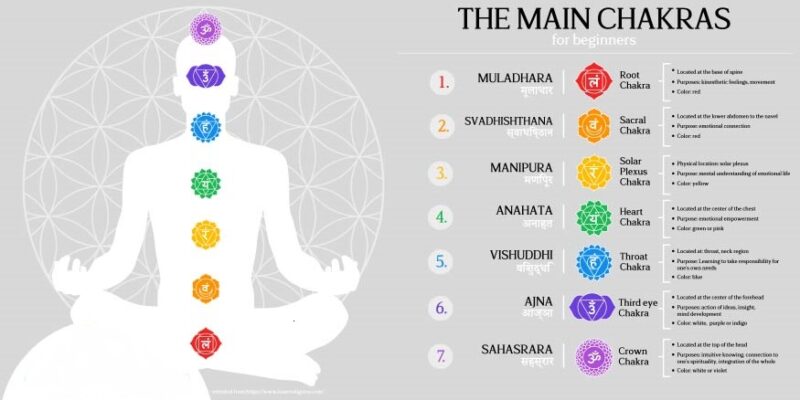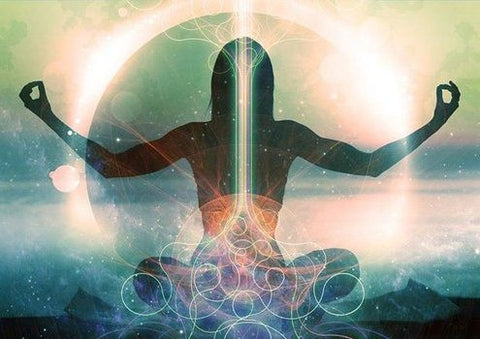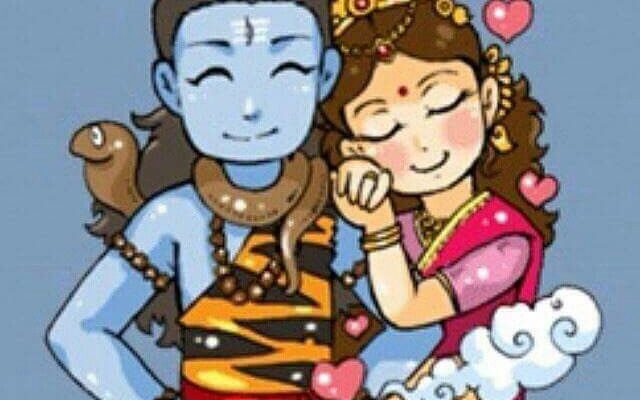When the being is at ajna chakra, point between eye brows, source of creation appears as a star that is…
Kundalini and Stages

Marshall Govindhan in his book Babaji and 18 Siddha Kriya Yoga Tradition writes about Kundalini and stages. The content below is an excerpt from his book.
Kundalini refers to that dormant power in the human organism which lies at the root of the spinal column. The word kundalini Sanskrit means “coil”, and so kundalini has been referred to as that which is coiled. However, the word kunda also refers to a cavity or pit. In this sense, kunda refers to the skull cavity in which the brain ties. The dissection of the human brain reveals that it resembles a snake coiled upon itself.
The purpose of Kriya Kundalini Yoga, is to awaken this kundalini energy which requires much preparation and exercises, involving postures, mudras (psycho-physical gestures), bandhas (muscular locks), pranayama (breathing), meditation and mantras. When the aspirant is able to purify and balance certain subtle channels of energy, known as the idakalai and pingala nadis, in the spinal column, and gradually ignite this kundalini energy at the base of the spine, it begins to rise up through a central channeling the spinal cord, known as the sushumna nadi. As it rises, it passes through various psycho-energetic centers known as chakras. Those chakras are inter-connected with different dormant areas of the brain. As the kundalini passes through the chakras these dormant areas and all of our latent faculties and divine potentialities are awakened.
The 18 Siddhas have referred to kundalini, just awakened and difficult to control, as the goddess “Kali Devi”. In modern psychological terms this primal energy manifests at the level of the human subconscious. When this kundalini power can be controlled and when it brings peace and beatitude this has been referred to by the Siddhas as Durga, the beautiful goddess riding on a tiger. Kundalini when awakened, manifests itself as creative energy, at different levels of refinement. She is then worshipped in various forms of goddesses: Lakshmi, Parvati, Saraswati and other forms of the Divine Mother. Leaders with great personal magnetism, geniuses and those with great creative ability are the ones in whom kundalini has awakened particular dormant areas of the brain. It has manifested itself through them at varying levels of refinement depending upon their psychic inclinations and tendencies.
When kundalini is fully awakened, all dormant areas of the brain are awakened and Divinity is manifested through the individual. When kundalini awakens and reaches the sahasrara chakra, nirvikalpa (unfluctuating) samadhi, the highest level of consciousness, unfolds. The Siddhas referred to this as the union of Shiva and Parvati Shakti, in which the seer, the seeing and the seen merge as one.
When the kundalini awakens, the physical body begins to undergo changes as well. Its cells become charged and rejuvenated with a high voltage energy. Hormonal secretions may also change. A process of complete transformation is set in motion.
According to the 18 Siddhas’ science, the Kundalini Shakti is raised by the aspirant from the muladhara by means of various yogic practices to the sahasrara where it unites with Shiva, the supreme static consciousness. The body’s two poles are united and cosmic consciousness emerges. The aspirant enjoys heavenly bliss and an ambrosial nectar begins to secrete into the blood stream, rejuvenating cells and prolonging life.
The Siddhas worshipped this Kundalini Shakti as the Universal Mother and in the form of a triangle. This has been further multiplied into Forty Three Triangles, Sri Chakra. By immense devotion to the Supreme Mother and meditation on the sacred mantras and hymns relating to the Forty three Triangles, the Siddhas gained mastery over the elements.
The Stages of Practice and Awakening of Kundalini
It is extremely important that one practice the various techniques in stages so that the ida and pingala nadis are purified and the chakras and shushumna are awakened before the kundalini itself is awakened. If not, there will be difficult problems and negative effects. If the chakras are not awakened before the kundalini, the energy will get blocked in one of the chakras, multiplying the force of the behavior associated with that chakra. One may develop some siddhis, or powers such as clairvoyance, but one will not be able to get beyond them. If one has unfulfilled desires and negative tendencies a premature awakening of the kundalini will feed these tremendously.
If the kundalini awakens before the shushumna nadi awakens, the energy will not rind an outlet, and will be stuck in the muladhara chakra, resulting in many sexual and neurotic problems. It is also important that the chakras awaken gradually. If awakened too quickly one may be overwhelmed by feelings of passion, fear, anxiety, greed, depression or memories of past lives.
The first stage of the practice of kundalini yoga therefore is the purification of the nadis by practicing asanas, bandhas, mudras and later pranayama. The student should also adopt a vegetarian diet, avoid stimulants of all kinds, as well as over consumption, irregular eating and negative behavior which cause disequilibrium in the alternate flow of prana through idakalai and pingalai nadis.
The practice of meditation will assist the student during this stage to eliminate negative behavior tendencies and to develop calm awareness. Babaji’s first Dhyana Kriya, or meditation technique, in particular purifies the chittam, or subconscious mind, which is the source of habitual tendencies and negative behavior.
Involvement in activities which include selfless service to others, study of the lives of saints and spiritual and metaphysical books, and devotional activities should also be done to sublimate the flow of pranic energy to the higher chakras. Most students are prone to inertia or dispersion of their energies. A calm equilibrium must be developed and maintained in all events, so that when kundalini does awaken, it may be controlled without disturbing effects.
The practice of pranayama should also be limited in the beginning, otherwise it will food negative tendencies, like anger, greed and lust. Under the guidance of an experienced teacher, the amount of practice can gradually be increased, as one’s capacity and purification progresses. Individuals will vary in their degree of preparedness, depending upon the kinds of lives they have lived before and their actual mental, emotional and physical habits. A competent teacher will be able to prescribe various kriyas and activities during this preparatory stage.
The second preparatory stage involves the awakening of the chakras. Depending upon the individual, some of the chakras may already be awakened, particularly if during a previous life one has practiced yoga or similar disciplines. In most individuals the muladhara chakra is already active. This is why sexual awareness is one of the dominant features in the lives of most persons. It is important, however, not to allow one’s energies to become stuck in one of the lower chakras. There are numerous ways of awakening the chakras. The best methods are those which bring about a gradual awakening. These include the asanas, mudras and bandhas, and especially the bija (seed) mantras. Certain meditation dhyana kriyas focusing on the chakras are also very effective. The importance of bija mantras and how they should be learned is discussed in a subsequent chapter.
The third preparatory stage is the awakening of the shushumna nadi. Once the energies in the idakalai and pingalai nadis have been balanced, an awakening of the third nadi, the shushumna, occurs spontaneously. It is usually very volatile and sporadic, however, and so, to stabilize this awakening, certain practices involving pranayama and meditation to keep these two energies in balance are important. While the awakening is unstable, the kundalini may rise briefly to the swadhistanam or manipura chakras, but will then return to the muladhara. Only when the balance between ida and pingala is continuous will the kundalini awaken in an explosive manner going all the way up through the sushumna to the sahasrara chakra.
The Manifestations of the Kundalini Awakening
Sometimes people experience energy rising through the spinal cord with tingling sensations. This is not the awakening of the kundalini. It is a release of pranic energy from the muladhara chakra up through the pingalai nadi, and is known as pranotthana. It partially purifies the chakras, but is only a temporary experience and leaves no lasting change in consciousness, as is the case with the awakening of the higher chakras and kundalini itself.
With the awakening of the chakras come many pleasant and sometimes fantastic experiences. They are usually very beautiful and blissful. They may occur at any time. Feelings of heat and cold may then also be noted in their physical counterparts: the genitals, anus, navel, heart, and forehead.
This signals the need for a prolonged, concentrated effort, involving tapas, or intensive, single minded yogic practice. The place chosen for this should be one that has been purified by the yogic practice of yogis, saints, sages and siddhas. The support of dedicated friends and provision for one’s material needs will be necessary during this period, which may last many months, so that the practice can go on without a break. The guidance of an expert teacher or guru will also be useful. Many different yogic kriyas, or techniques will have to be used systematically.
With the awakening of the shushumna one may see a great light within, or feel that the spinal cord is full of light. Some unpleasant experiences such as heat along the spinal cord, fever, various odors.
Stages mentioned in Siddha Yoga
https://www.thekundaliniyoga.org/siddha_yoga/experiences_stages_of_siddha_yoga.aspx
https://www.lifesloka.com/en/awakening-of-kundalini-and-chakras/
Granthis or Knots
https://www.lifesloka.com/en/3-granthi-in-kundalini-yoga/
Kundalini Yoga Videos Playlist



